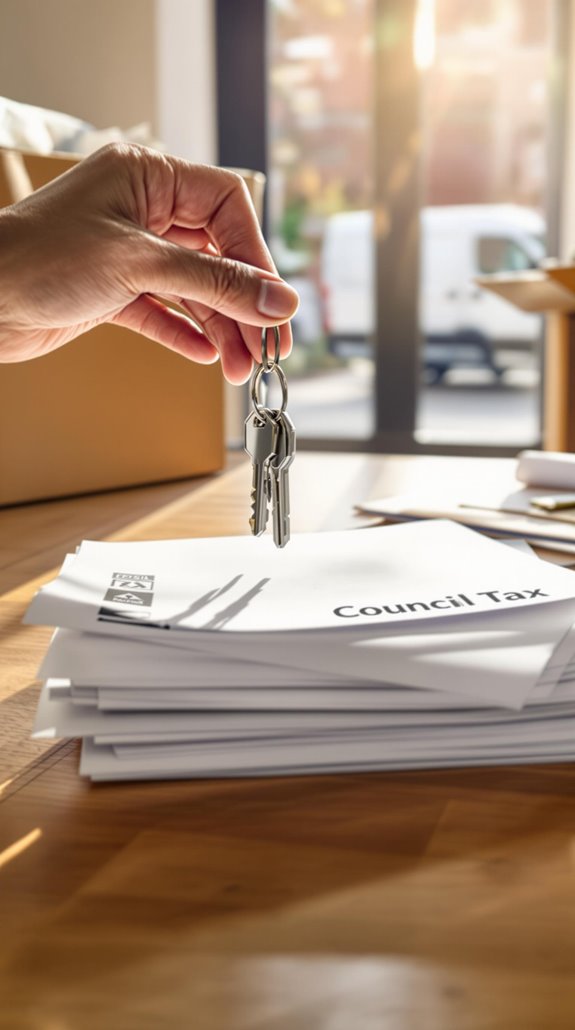I’ve helped hundreds of homeowners navigate council tax cancellation during house moves, and I can tell you that most people make costly mistakes simply because they don’t know the proper steps. You’re probably wondering how to avoid those extra charges that can add up to hundreds of pounds, or maybe you’re concerned about missing critical deadlines. There’s a specific sequence you must follow to protect yourself financially, and I’ll show you exactly what councils don’t want you to overlook.
Key Takeaways
- Notify your current council at least 2-3 weeks before moving to avoid overlapping bills and potential late fees.
- Use online portals for instant confirmation and faster processing of your council tax cancellation request.
- Provide exact move-out date and forwarding address to ensure accurate final bill calculation and refund delivery.
- Cancel direct debit only after receiving final payment confirmation to prevent overpayments and processing delays.
- Register with your new council within 21 days to avoid penalties and keep all documentation for disputes.
Understanding Council Tax and Why Cancellation Matters When Moving

When you’re preparing to move house, understanding council tax becomes essential since this local taxation system will follow you to your new property while requiring proper cancellation at your old address. Council tax funds your local services like waste collection, police, and schools, making it a priority debt that demands immediate attention during relocation.
I can’t stress enough how important timely cancellation is. Without proper notice, you’ll face overlapping bills for both properties, creating unnecessary financial strain during an already expensive time. Council tax authorities classify this as priority debt, meaning non-payment leads to serious consequences including bailiff action and court summons.
You’ll also miss out on potential refunds for overpayments if you delay notification, making prompt action financially beneficial for your moving budget. The council tax system operates across eight bands in England and Scotland, with your new property assigned to one of these bands based on its assumed capital value.
Essential Preparation Steps Before Cancelling Your Council Tax
Before you contact your council about cancelling your council tax, proper preparation saves you time and prevents costly mistakes. I’ll help you gather what you need to make this process smooth.
Start by locating your council tax account number—you’ll need this for identity verification. Write down your exact move-out date since this determines how your final bill gets calculated. Don’t forget your forwarding address for correspondence and potential refunds.
If you’re selling or ending a rental agreement, keep that documentation handy. List all adult occupants at your current property, as councils need these details for their records. Remember that you must notify the council within 21 days of moving to maintain compliance with local regulations.
Here’s what many people miss: check if you’ve overpaid and calculate potential refunds. Review your direct debit schedule to prevent unwanted charges after you’ve moved.
Three Main Methods to Notify Your Current Council
Once you’ve gathered your paperwork and details, you’ll need to formally notify your council about your move. I’ll walk you through three reliable methods that guarantee your cancellation gets processed quickly.
Online Portal Method
Most councils offer secure online forms through their websites. You’ll log in, complete the moving details, and receive instant confirmation. This method works 24/7 and provides immediate proof of submission.
Phone Call Method
Ring your council’s tax department directly. Have your council tax reference number ready, plus your moving dates and new address. They’ll update your account immediately and provide a reference number for your records. Remember that failing to notify promptly may result in continued tax obligations even after you’ve moved out.
Written Notice Method
Email or post a formal letter including all essential details. While slower, this creates a paper trail that protects you if disputes arise later.
Key Information You Must Provide to Cancel Successfully
Although each council handles cancellations differently, they’ll all require the same core information to process your request properly.
You’ll need your exact move-out date – this determines when your liability ends and affects your final bill calculation. They’ll also want your forwarding address for sending final bills, refunds, or correspondence.
Make sure you’ve got your current property details ready: full address, council tax account number, and any reference numbers from previous communications. This helps them locate your account quickly.
Don’t forget occupant information – they need names of all adults over 18 who lived at the property, plus details about any discounts you’ve been receiving. If you have any unpaid council tax, make sure to clear these amounts before proceeding with the cancellation.
Finally, mention any special circumstances like the property remaining vacant, as this might affect future billing arrangements.
Managing Final Payments and Claiming Refunds
After you’ve notified your council about moving, they’ll issue a final bill that covers your liability period up to your move-out date. This bill includes pro-rata calculations and any adjustments for partial months or outstanding balances.
I recommend settling your final payment within 14 days using the council’s online portal, phone line, or bank transfer to avoid late fees. Don’t forget to cancel your direct debit after payment to prevent overpayments.
If you’ve overpaid, you’ll automatically receive a refund within 4-6 weeks to your linked bank account. If your bank details have changed, you’ll need to request the refund manually through the council’s portal. For phone payments, you can call the council’s automated line which operates 24 hours a day, seven days a week for convenient immediate settlement.
Always request written confirmation of account closure and keep payment receipts for 12 months as proof of settlement.
Registering Council Tax at Your New Address
While settling your final council tax bill marks the end of your previous address obligations, registering at your new property requires immediate attention to avoid penalties and billing complications. You’ll need to notify your new council within 21 days – it’s a legal requirement that protects you from backdated charges.
Most councils offer online registration forms that streamline the process. I recommend registering up to 10 working days before your move to secure extra time for payment arrangements. You’ll need your council tax reference number, bank details for direct debit setup, and landlord contact information if you’re renting.
If you’re staying within the same borough, your account credits transfer automatically. Moving between councils requires separate registration with your new authority while confirming your departure with the previous one. When moving, you’ll have different options for online address changes depending on whether you’re moving within the same area, into a new area, or out of the jurisdiction entirely.
Common Mistakes That Cost You Money When Moving
Moving house creates a minefield of costly council tax errors that can drain hundreds from your budget. I’ve seen people lose £280 in escalated fines simply because they ignored council notices or failed to respond within 21 days. Don’t let direct debits continue draining your old property account – you’ll end up paying for both homes simultaneously.
The biggest mistake? Reporting incorrect move-out dates. You’re liable until your resident status officially ends, and inaccurate dates trigger overpayments and refund delays. When councils send communications, respond immediately. Ignoring them triggers automatic penalties and legal consequences.
Cancel your old tax account properly and update banking details to prevent unauthorized withdrawals. Most importantly, claim your refunds – those overpaid periods and vacant property adjustments are your money waiting to be recovered. Remember that empty property tax can be charged after two years of vacancy, adding another layer of costs to consider.
Timeline and Deadlines for Council Tax Cancellation
Getting your council tax cancellation timeline right prevents costly overlaps and guarantees you’re not paying for two properties simultaneously. I recommend notifying your current council at least two weeks before moving, though three weeks provides better cushion for processing delays.
You’ll need your exact move-out date ready – councils use this to prorate your final bill accurately. If you’re selling, provide the completion date. For rentals, give your tenancy end date.
The cancellation process typically takes two weeks, so early notification is essential. Starting late means you’ll pay for both properties initially, then wait for refunds – an unnecessary hassle that ties up your money. Council tax refunds for overpaid amounts typically take 2-4 weeks to process once requested.
Contact your new council within days of moving to establish your account and avoid gaps in coverage.
What Happens After You Submit Your Cancellation Request

Once you submit your cancellation request, your council springs into action with a series of automated processes that’ll wrap up your account within weeks.
First, you’ll receive your final bill within 7-14 days. This includes all charges up to your move-out date, prorated if necessary. If you’ve overpaid, the council automatically initiates a refund via bank transfer within four weeks – though amounts under £10 typically won’t be refunded. In 2024, over £1.2 billion in council tax refunds were claimed by residents across the UK.
You’ll get written confirmation once your account closes successfully. Keep this documentation for two years as proof against future disputes.
Here’s what’s vital: register with your new council within 21 days to avoid backdated bills and penalties. Check your bank statements carefully to catch any duplicate charges, and verify your closure confirmation to prevent overlap between old and new registrations.
Conclusion
Moving house doesn’t have to mean paying double council tax or dealing with bureaucratic headaches. By following these straightforward steps—gathering your account details, notifying your council two weeks ahead, and providing complete information—you’ll avoid costly mistakes and guarantee a smooth shift. Don’t let poor planning cost you money. Take action now, cancel your council tax properly, and focus on settling into your new home stress-free.
References
- https://www.towerstone.co.uk/how-to-cancel-council-tax
- https://www.178wing.ang.af.mil/Portals/69/documents/afh33-337.pdf?ver=2016-12-15-101008-313
- https://hirefleet.co.uk/news/how-to-cancel-council-tax-when-moving-house
- https://www.courts.michigan.gov/4a4a11/siteassets/publications/manuals/msc/miappopmanual.pdf
- https://slothmove.com/how-to-cancel-council-tax-when-moving-house/
- https://en.wikipedia.org/wiki/Council_Tax
- https://www.strongmove.co.uk/blog/cancel-council-tax-moving-house/
- https://www.gov.uk/council-tax
- https://www.creditfix.co.uk/blog/how-to-cancel-your-council-tax/
- https://www.citizensadvice.org.uk/housing/council-tax/paying-council-tax/

